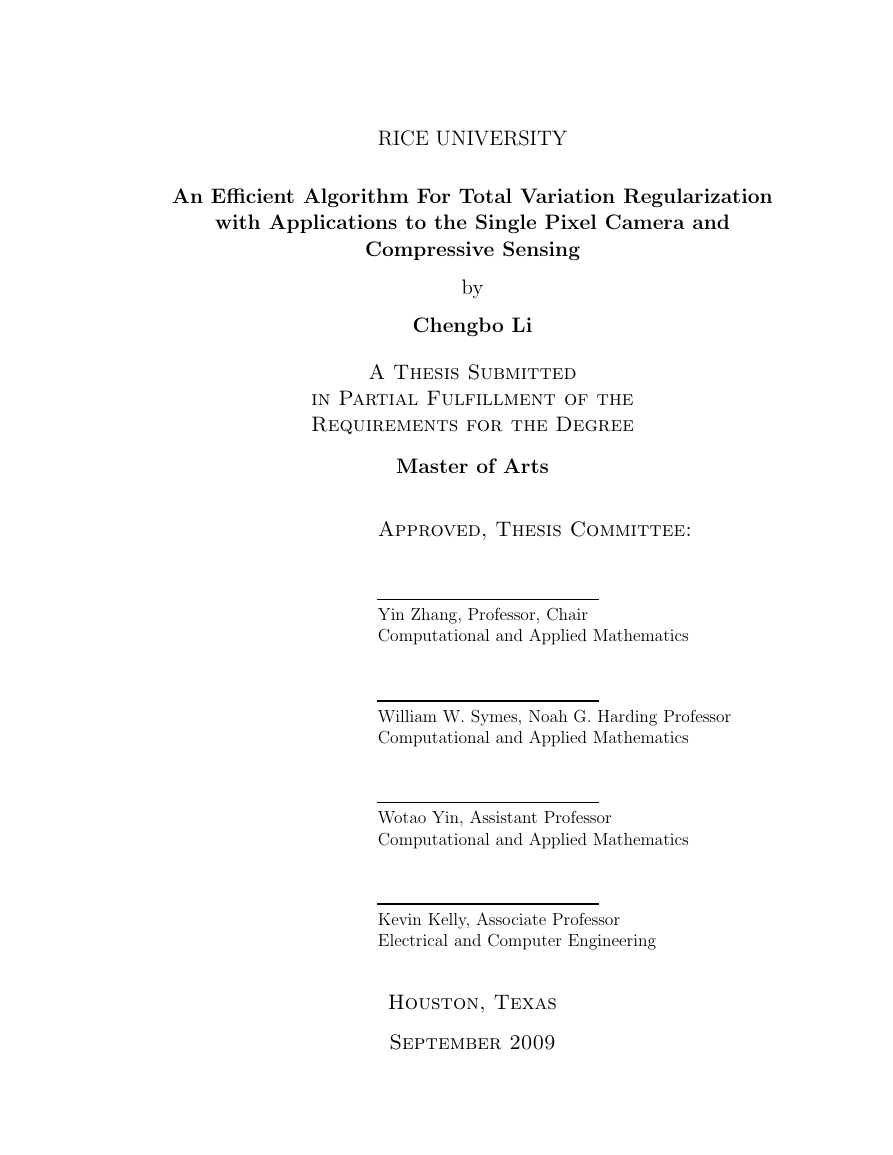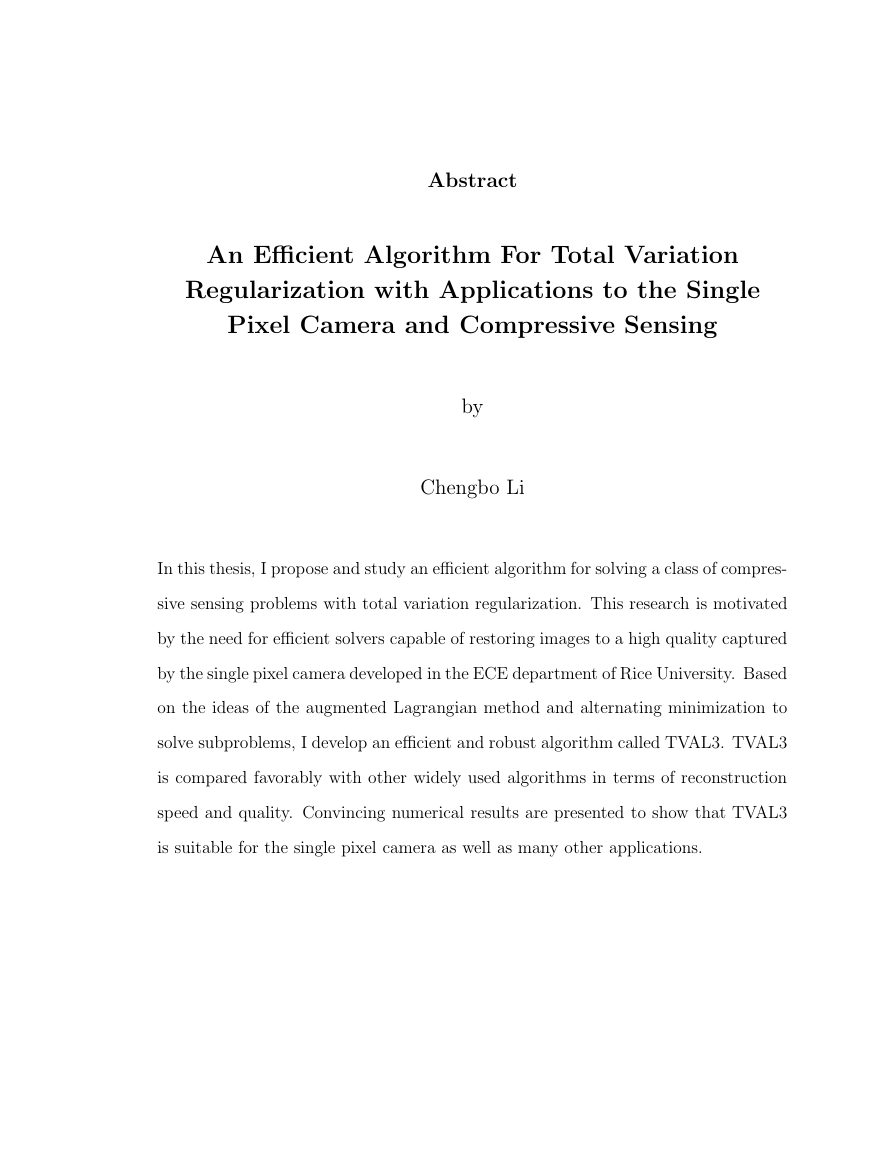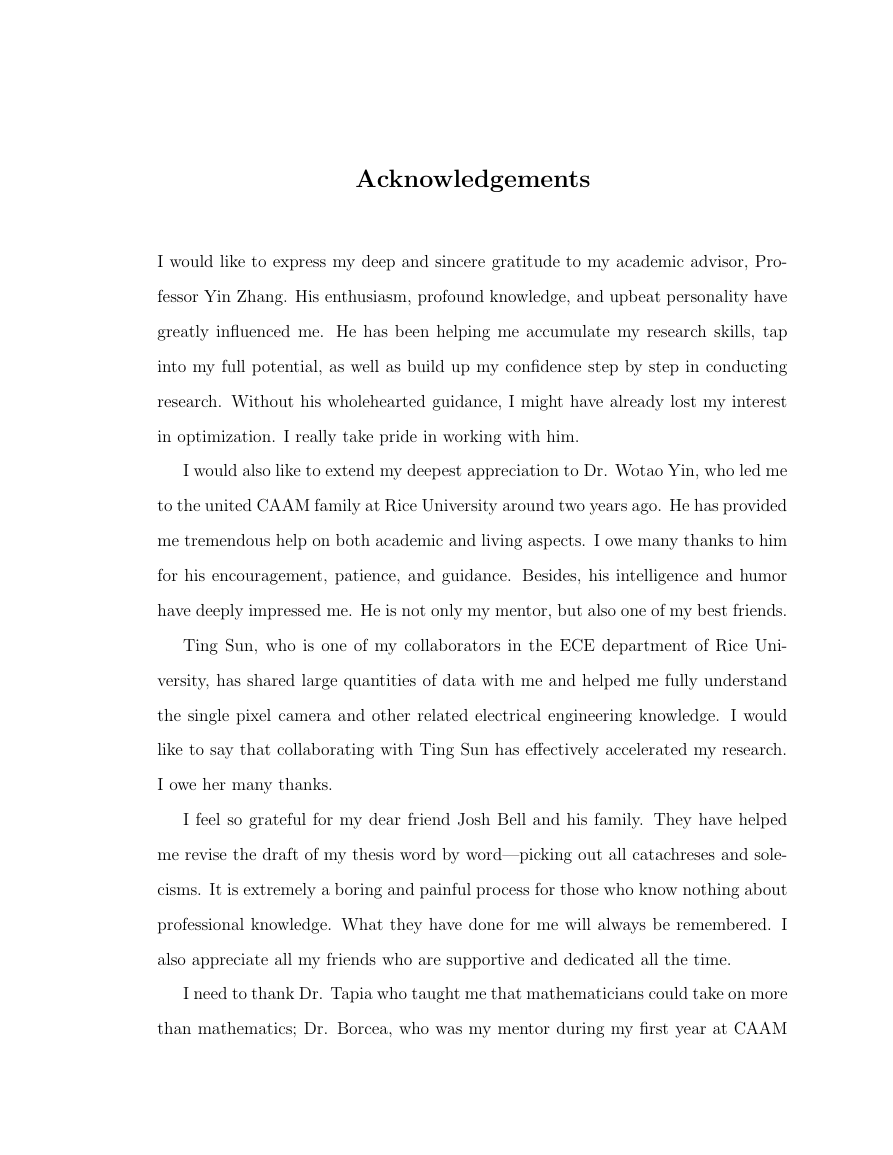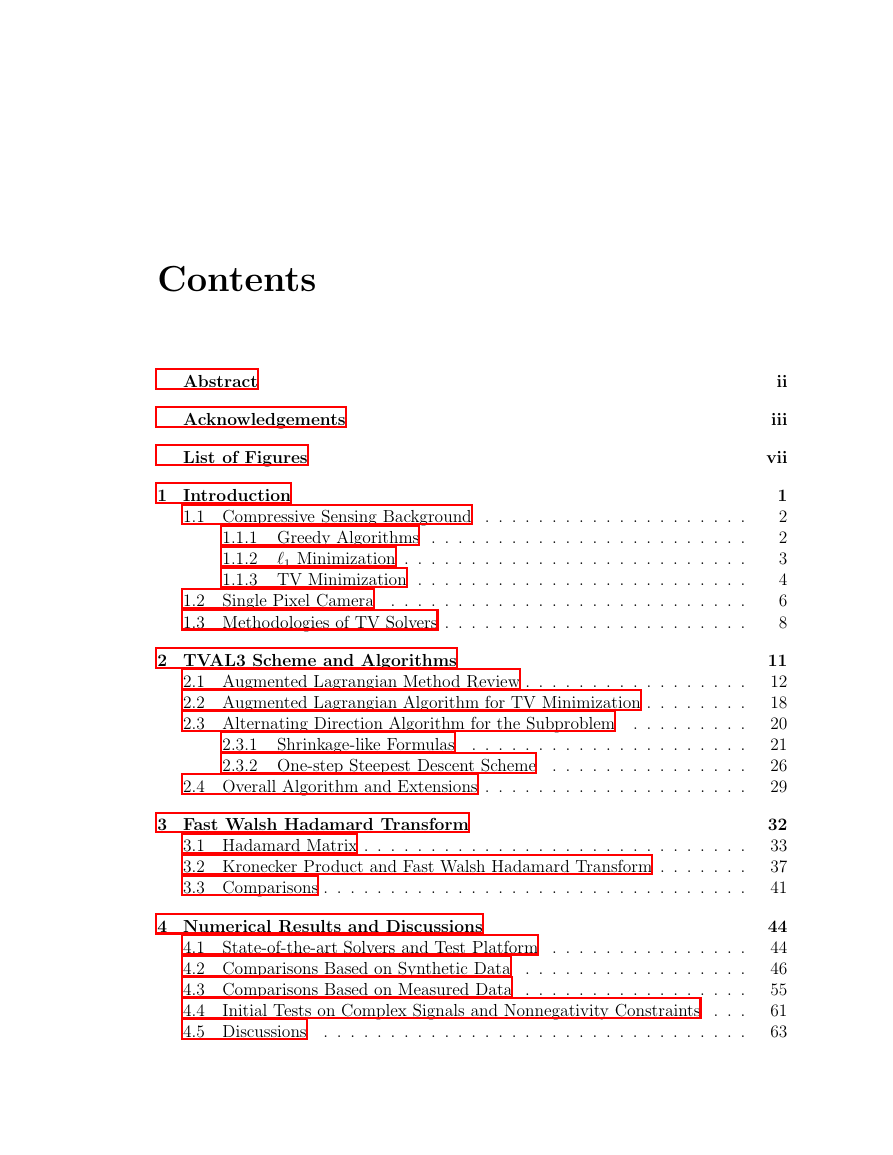RICE UNIVERSITY
An Efficient Algorithm For Total Variation Regularization
with Applications to the Single Pixel Camera and
Compressive Sensing
by
Chengbo Li
A Thesis Submitted
in Partial Fulfillment of the
Requirements for the Degree
Master of Arts
Approved, Thesis Committee:
Yin Zhang, Professor, Chair
Computational and Applied Mathematics
William W. Symes, Noah G. Harding Professor
Computational and Applied Mathematics
Wotao Yin, Assistant Professor
Computational and Applied Mathematics
Kevin Kelly, Associate Professor
Electrical and Computer Engineering
Houston, Texas
September 2009
�
Abstract
An Efficient Algorithm For Total Variation
Regularization with Applications to the Single
Pixel Camera and Compressive Sensing
by
Chengbo Li
In this thesis, I propose and study an efficient algorithm for solving a class of compres-
sive sensing problems with total variation regularization. This research is motivated
by the need for efficient solvers capable of restoring images to a high quality captured
by the single pixel camera developed in the ECE department of Rice University. Based
on the ideas of the augmented Lagrangian method and alternating minimization to
solve subproblems, I develop an efficient and robust algorithm called TVAL3. TVAL3
is compared favorably with other widely used algorithms in terms of reconstruction
speed and quality. Convincing numerical results are presented to show that TVAL3
is suitable for the single pixel camera as well as many other applications.
�
Acknowledgements
I would like to express my deep and sincere gratitude to my academic advisor, Pro-
fessor Yin Zhang. His enthusiasm, profound knowledge, and upbeat personality have
greatly influenced me. He has been helping me accumulate my research skills, tap
into my full potential, as well as build up my confidence step by step in conducting
research. Without his wholehearted guidance, I might have already lost my interest
in optimization. I really take pride in working with him.
I would also like to extend my deepest appreciation to Dr. Wotao Yin, who led me
to the united CAAM family at Rice University around two years ago. He has provided
me tremendous help on both academic and living aspects. I owe many thanks to him
for his encouragement, patience, and guidance. Besides, his intelligence and humor
have deeply impressed me. He is not only my mentor, but also one of my best friends.
Ting Sun, who is one of my collaborators in the ECE department of Rice Uni-
versity, has shared large quantities of data with me and helped me fully understand
the single pixel camera and other related electrical engineering knowledge. I would
like to say that collaborating with Ting Sun has effectively accelerated my research.
I owe her many thanks.
I feel so grateful for my dear friend Josh Bell and his family. They have helped
me revise the draft of my thesis word by word—picking out all catachreses and sole-
cisms. It is extremely a boring and painful process for those who know nothing about
professional knowledge. What they have done for me will always be remembered. I
also appreciate all my friends who are supportive and dedicated all the time.
I need to thank Dr. Tapia who taught me that mathematicians could take on more
than mathematics; Dr. Borcea, who was my mentor during my first year at CAAM
�
iv
and helped me adapt the new environment; Dr. Hewitt who offered suggestions of
my usage of the English Language and recommendations for my presentations on
several occasions; my committee members Dr. Symes and Dr. Kelly who earnestly
reviewed my thesis. Besides, I feel grateful for all other professors who have provided
me knowledge and expertise during my undergraduate and graduate studies.
Last but certainly not least, I am grateful for my parents, grandfather, and grand-
mother for their selfless love and unconditional support throughout these years. You
are the love of my entire life.
I am willing to dedicate this thesis to my dear Yun to commemorate all things
between us.
�
Contents
Abstract
Acknowledgements
List of Figures
1 Introduction
1.1 Compressive Sensing Background . . . . . . . . . . . . . . . . . . . .
1.1.1 Greedy Algorithms . . . . . . . . . . . . . . . . . . . . . . . .
1.1.2
ℓ1 Minimization . . . . . . . . . . . . . . . . . . . . . . . . . .
1.1.3 TV Minimization . . . . . . . . . . . . . . . . . . . . . . . . .
1.2 Single Pixel Camera . . . . . . . . . . . . . . . . . . . . . . . . . . .
1.3 Methodologies of TV Solvers . . . . . . . . . . . . . . . . . . . . . . .
2 TVAL3 Scheme and Algorithms
2.1 Augmented Lagrangian Method Review . . . . . . . . . . . . . . . . .
2.2 Augmented Lagrangian Algorithm for TV Minimization . . . . . . . .
2.3 Alternating Direction Algorithm for the Subproblem . . . . . . . . .
. . . . . . . . . . . . . . . . . . . . .
. . . . . . . . . . . . . . .
2.4 Overall Algorithm and Extensions . . . . . . . . . . . . . . . . . . . .
2.3.1
2.3.2 One-step Steepest Descent Scheme
Shrinkage-like Formulas
3 Fast Walsh Hadamard Transform
3.1 Hadamard Matrix . . . . . . . . . . . . . . . . . . . . . . . . . . . . .
3.2 Kronecker Product and Fast Walsh Hadamard Transform . . . . . . .
3.3 Comparisons . . . . . . . . . . . . . . . . . . . . . . . . . . . . . . . .
4 Numerical Results and Discussions
4.1 State-of-the-art Solvers and Test Platform . . . . . . . . . . . . . . .
4.2 Comparisons Based on Synthetic Data . . . . . . . . . . . . . . . . .
4.3 Comparisons Based on Measured Data . . . . . . . . . . . . . . . . .
Initial Tests on Complex Signals and Nonnegativity Constraints . . .
4.4
4.5 Discussions
. . . . . . . . . . . . . . . . . . . . . . . . . . . . . . . .
ii
iii
vii
1
2
2
3
4
6
8
11
12
18
20
21
26
29
32
33
37
41
44
44
46
55
61
63
�
5 Future Work
vi
65
66
66
68
5.1 Hyperspectral Imaging . . . . . . . . . . . . . . . . . . . . . . . . . .
. . . . . . . . . . . . . . . . . . . . . . . . . .
Initial Formulation . . . . . . . . . . . . . . . . . . . . . . . .
5.1.1 Basic Concepts
5.1.2
5.1.3 Parallel Algorithms and Implementations on High Performance Computers 71
5.2 Exploration on Dual Method . . . . . . . . . . . . . . . . . . . . . . .
5.2.1 Derivation of Dual Problem . . . . . . . . . . . . . . . . . . .
5.2.2 Methodology on Dual Problem . . . . . . . . . . . . . . . . .
Bibliography
72
73
76
78
�
List of Figures
1.1 Single pixel camera block diagram . . . . . . . . . . . . . . . . . . . .
3.1 Running time comparison between two FWHT implementations . . .
3.2 Running time comparison between FWHT and FFT . . . . . . . . . .
4.1 Reconstructed 1D staircase signal
. . . . . . . . . . . . . . . . . . . .
4.2 Recoverability for 1D staircase signals . . . . . . . . . . . . . . . . . .
4.3 Recovered phantom image from orthonormal measurements . . . . . .
4.4 Recovered phantom image from non-orthonormal measurements . . .
4.5 Recovered MR brain image . . . . . . . . . . . . . . . . . . . . . . . .
4.6 Recoverability for MR brain image
. . . . . . . . . . . . . . . . . . .
4.7 Real target in visible light . . . . . . . . . . . . . . . . . . . . . . . .
4.8 Recovered infrared RI image . . . . . . . . . . . . . . . . . . . . . . .
4.9 Recovered the transistor image
. . . . . . . . . . . . . . . . . . . . .
4.10 Recovered 1D complex staircase signal
. . . . . . . . . . . . . . . . .
4.11 Recovered CT thorax image . . . . . . . . . . . . . . . . . . . . . . .
6
42
43
46
47
49
50
52
53
56
58
59
62
62
�
Chapter 1
Introduction
This thesis concentrates on developing an efficient algorithm which solves a well-
known compressive sensing (also known as compressed sensing or CS) problem with
total variation (TV) regularization. The main application of this algorithm is to
reconstruct the high-resolution image captured by a single pixel camera (SPC). The
basic questions are: what is the background and motivation of this research, what
methods are used, why is a new algorithm necessary, and how does this new algorithm
behave compared with other existing solvers or algorithms? All of these questions
will be answered step by step in this thesis.
The basic background including compressive sensing and single pixel camera, ex-
isting reconstruction algorithms, and the general methodology are introduced in this
chapter. The second chapter, one of the most essential chapters in this thesis, de-
scribes the main algorithm in detail and introduces the corresponding solver TVAL3
[98]. A structured measurement matrix correlating to the single pixel camera and
how this measurement matrix is able to improve the algorithm will be discussed in
the following chapter. The algorithm described in this thesis compares favorably with
several state-of-the-art algorithms in the fourth chapter of this thesis. Numerical re-
1
�
















 2023年江西萍乡中考道德与法治真题及答案.doc
2023年江西萍乡中考道德与法治真题及答案.doc 2012年重庆南川中考生物真题及答案.doc
2012年重庆南川中考生物真题及答案.doc 2013年江西师范大学地理学综合及文艺理论基础考研真题.doc
2013年江西师范大学地理学综合及文艺理论基础考研真题.doc 2020年四川甘孜小升初语文真题及答案I卷.doc
2020年四川甘孜小升初语文真题及答案I卷.doc 2020年注册岩土工程师专业基础考试真题及答案.doc
2020年注册岩土工程师专业基础考试真题及答案.doc 2023-2024学年福建省厦门市九年级上学期数学月考试题及答案.doc
2023-2024学年福建省厦门市九年级上学期数学月考试题及答案.doc 2021-2022学年辽宁省沈阳市大东区九年级上学期语文期末试题及答案.doc
2021-2022学年辽宁省沈阳市大东区九年级上学期语文期末试题及答案.doc 2022-2023学年北京东城区初三第一学期物理期末试卷及答案.doc
2022-2023学年北京东城区初三第一学期物理期末试卷及答案.doc 2018上半年江西教师资格初中地理学科知识与教学能力真题及答案.doc
2018上半年江西教师资格初中地理学科知识与教学能力真题及答案.doc 2012年河北国家公务员申论考试真题及答案-省级.doc
2012年河北国家公务员申论考试真题及答案-省级.doc 2020-2021学年江苏省扬州市江都区邵樊片九年级上学期数学第一次质量检测试题及答案.doc
2020-2021学年江苏省扬州市江都区邵樊片九年级上学期数学第一次质量检测试题及答案.doc 2022下半年黑龙江教师资格证中学综合素质真题及答案.doc
2022下半年黑龙江教师资格证中学综合素质真题及答案.doc